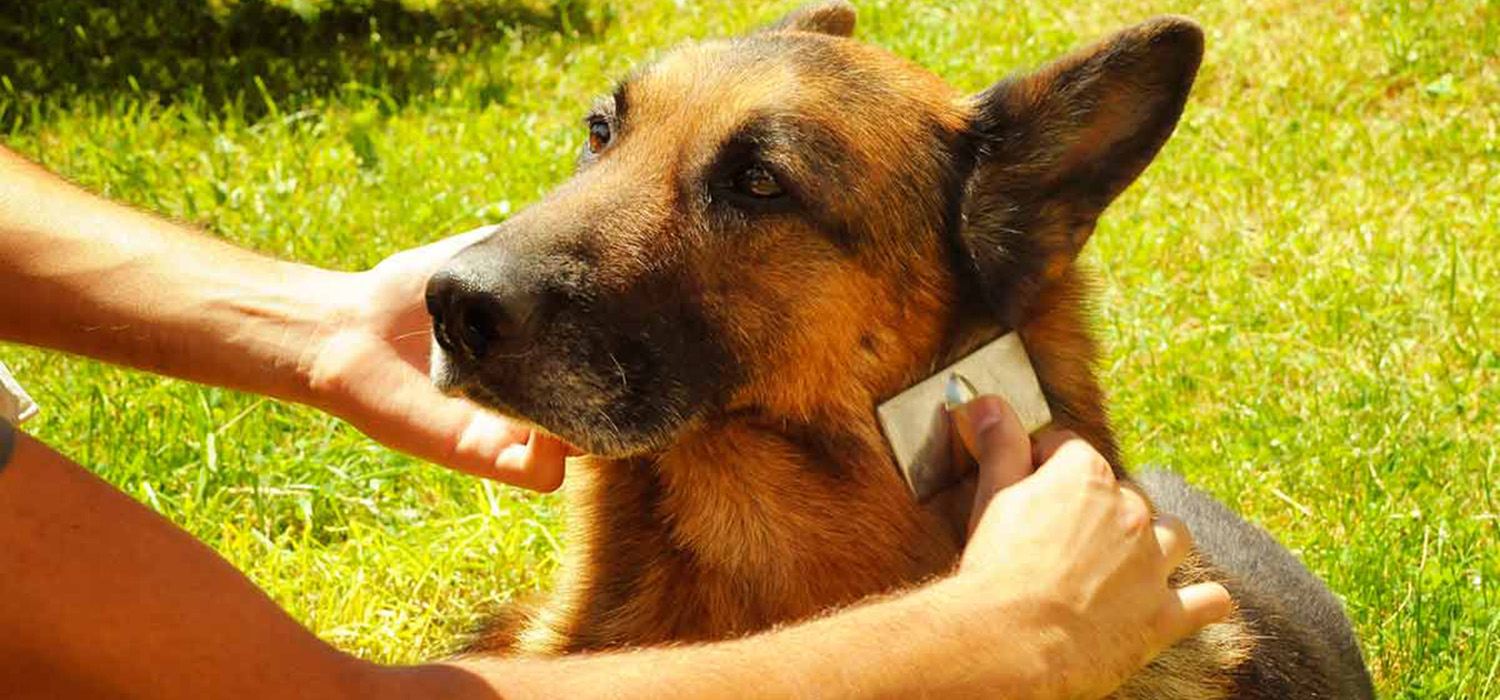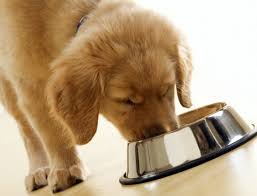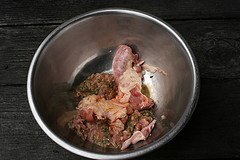Feeding your dog properly is critical to a dog’s overall health and wellbeing. Without realizing it, we can kill our dogs with kindness by including extra tit-bits at the table or little treats now and then during the day. These extras, on top of his ordinary meal, will mean the dog will soon start to put on weight. The rule of thumb is that a slightly underfed dog is better than an overfed dog.
Chewy.com has a great range of quality brand dog foods – check out their current specials here!
When you first bring your puppy, or dog home, it is best to continue with the brand and type of dog food the puppy breeder, or previous owner, has been feeding. They will also advise how much you should feed your puppy. Sudden changes in dog food can cause the dog to have upset stomach, causing vomiting and diarrhoea. If you want to switch the food types, do it slowly and gradually over a period of time so that the dog becomes accustomed to it.
Dog food brands have become more inclusive these days with specific foods for different health issues and conditions, specific foods for different dog breeds as well as specific food preparations for puppies, active adult dogs and less active adult dogs. It is difficult to know what to consider when choosing a particular food type for your puppy or dog. This is why it is best to continue following the diet that the previous owner or dog breeder adopted. If you do plan to change, gradually introduce a small portion of the new food in with the existing food type and then increase slightly each day until the dog has adjusted to it.
When considering the feeding routine for your dog you will need to consider the type of food you are going to give your dog. Premium dog food can sometimes be over-rated and some of these have added chemicals, preservatives and colourings. Do you feed wet food (fresh meat or dog meat rolls), dry food (biscuits) or raw food (raw meat and bones) and holistic/natural foods? Or, to make the meal more interesting for your dog, you could mix a little wet food with some dry food biscuits. There is an endless variety of dog food brands to choose from, and it is a matter of you choosing something that fits within your price range and requirements for the dog.
You will probably find that the cheapest foods in the market will have a high proportion of fillers and additives with less meat. The more expensive the product will most likely be the better quality with less fillers and additives. Also, the health-specific brands, such as Hills Science Diet, which are designed to cater for dogs with specific health conditions, will be more expensive than most. If you are not sure what the best dog food would be then it is best if you check with your veterinarian for a recommendation.
Wet Food (Dog Meat, Dog Meat Rolls and Soft Food)
In the wild, dogs would normally eat raw meat flesh from other animals that they kill. Their stomachs are designed to process raw foods however with today’s lifestyle, meat generally comes in the form of branded meat rolls, canned dog food or packets, fortified with additional nutrients and sometimes additives such as rice, corn, wheat and/or vegetables.
Dry Food (Biscuits and Kibble)
Dry dog food is another option with a wide range of brands to choose from. A good quality dry dog food or kibble will be more expensive and depending on whether it is a generic or specialty formulation, will be priced accordingly. Some of these formulations are very specific and so it would be best not to mix these with any other type of food. Feeding your dog will be best if using a brand that uses less fillers and additives, such as preservatives, flavors and coloring, however this may be more expensive.
BARF Food (Raw Food)
A natural BARF diet is one which consists of purely raw meat and bones, as a wild dog would normally eat. A natural BARF diet would include such ingredients as bones, muscle meat, fat and organs as well as vegetable matter, that mimics the way the ancestors would have eaten. Before deciding upon this method of feeding your dog, it is important to do some research and check with your vet. Eggs, yoghurt, kelp, fish, organ meat, as well as bones (see next paragraph) and cartilage plus supplements could be incorporated into this diet however it would need to be closely monitored for your dog’s balance nutrition requirements.
When it comes to bones, if you are feeding a BARF diet, be careful not to feed cooked bones as they can splinter in the dog’s stomach and be dangerous! Bones should not be given too often and make sure that they are larger and more solid bones that are less likely to splinter in the dog’s stomach. Chicken carcasses can be given from time to time, however definitely not the smaller bones of the chicken, such as legs and wings, as these can easily get stuck in the dog’s stomach.
 Prefer raw and natural dog foods. Cherrybrook has a great range here!
Prefer raw and natural dog foods. Cherrybrook has a great range here!
Home Cooked Meals
The other alternative to purchasing the above dog food types, is that of cooking food for your dog yourself. Once again, it is important to make sure that your dog is receiving all the nutrients required and so regular check-ups at the vet to get advice on this is important. If you choose this option of feeding your dog, then include in the diet a portion of meat, vegetables with additions of eggs, yogurt, etc.
Foods That are Known to be Dangerous to Dogs
When considering what you feed your dog and when you feed it, that there are common human foods which are potentially dangerous for dogs to eat. These include: Alcohol, avocado, chocolate, caffeine (in all forms), corn, grapes and raisins, macadamia nuts, onions and garlic (in very small amounts these may not be too harmful if eaten on rare occasions, but best to avoid), sugary foods including milk/dairy products such as ice cream, and yeast dough.
These are the main ones to watch out for however if you notice your dog has eaten something which causes diarrhea and vomiting then it will be best to remove that from the diet also.
How To Tell If Your Dog Is Overweight
The shape of the body should be such that you can see a definite shape of the ribs and you should be able to feel the last rib. Towards the back end you should see the body narrow slightly towards the hips. If you can’t feel or see this shape then your dog is overweight. The best way to do this is to reduce what you normally feed your dog. Make an effort to give him/her more free running exercise or get involved in a dog club and their sports or activities.
If you think your dog might be overweight then speak to your vet. Vets can better assess your dog’s overall condition and recommend the best dog food to feed. Generally, a diet of weight management biscuits which are not so high in protein plus with daily exercise will be very beneficial. As with humans, excess weight can be the instigator of numerous other health issues, so it is important to keep this under control.
How To Tell If Your Dog Is Underweight
An underweight dog will look very scrawny and malnourished. If you can see the ribs protruding quite visibly as well as the dog looking sickly and a dull looking coat, chances are that he/she is going to need some building up. You might be best to take the dog to the vet for advice in this situation.
The ideal weight of a dog should be a visible shape of the rib cage and you should be able to feel the ribs. Be aware that in a thick and long coated dog this can be a little deceiving. You may think the dog looks overweight but really underneath all the thickness the body is actually quite trim. With these types of dogs always feel underneath the coat for the rib cage and run your hands down the sides holding the coat in to try and get an idea of the shaping inwards at the rear. If you are not sure then get it checked out by your vet. An underlying disease or illness can sometimes be the cause of dogs becoming underweight.
Natural health remedies can be helpful in the management of weight problems in dogs by balancing out the metabolism in both overweight and underweight dogs.
If you are interested in finding out more about feeding your dog, then you may want to add these to your bookshelf.
If feeding habits include you giving your dog treats during the day, then cut down on the amount of food in the main meal, however keep these treats to a minimum and for special occasions only. These are not nutritionally balanced foods and best used for rewards, etc. So, if you use treats in training your dog as a reward, then reduce the amount you feed your dog at meal time. Overfeeding your dog, which causes your dog to become overweight can, like humans, cause a multitude of health problems such as pressure on the heart, press on the joints, hips, diabetes, etc. and can lessen, in the long term, the life of your dog. These health conditions will end up being a bigger expense for you in veterinary bills to rectify the dog’s health condition.
I haven’t mentioned in this dog feeding section about the importance of exercise and activities for your dog’s mental and physical health. Refer to the section on dog activities which is, along with correct dog feeding routines, critical to your dog’s overall health and weight situation.
Dog Feeding Accessories
It goes without saying that if you buy dog food in bulk, then storing it appropriate containers is essential to keep the freshness. Why not look at the selection of dog food storage containers at PetCareRx.com.




